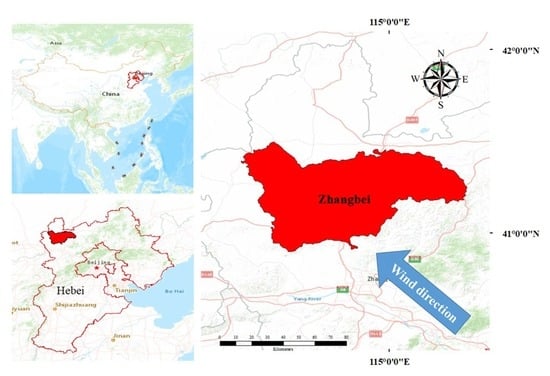Assessment of Permeability Windbreak Forests with Different Porosities Based on Laser Scanning and Computational Fluid Dynamics
Abstract
:1. Introduction
2. Materials and Methods
2.1. Selection of the Study Area
2.2. Data Acquisition
2.2.1. Acquisition of Sample Plot Inventory Data
2.2.2. Measurement of Wind Speed and Air Volume
2.2.3. Calculation of Air Permeability Coefficient
2.2.4. Calculation of Absolute Error, Relative Error, and RMSE
2.2.5. Calculation of Porosity
2.3. Point Cloud Data Processing
2.3.1. Acquisition of TLS Data
2.3.2. Filtering of Ground and Off-Ground Points
2.3.3. Three-Dimensional Structural Reconstruction of the Windbreak Forest Belt
2.4. Wind Field Simulation
2.4.1. Geometric Model and Computational Domain
2.4.2. Boundary Conditions
2.4.3. Numerical Model
3. Results and Analysis
3.1. Model Accuracy Validation
3.1.1. Comparison of Simulated and True Values of Wind Speed
3.1.2. Comparison of Model Structure and True Values of Individual Trees in Windbreak Forests
3.2. Reliability Analysis of Actual Wind Speed Measurements and Each Simulation Result
3.3. Velocity Analysis of Different Positions
3.4. Kinetic Energy Cloud Diagram for Three Models
4. Discussion
4.1. AdQSM Applicability Assessment
4.1.1. Restoring the Structural Aspects of Trees
4.1.2. Fitting of Wind Permeability Coefficient and Porosity
4.2. Accuracy Analysis of Measured Wind Field Data and Simulated Wind Field Data
4.3. Study Limitations
5. Conclusions
Author Contributions
Funding
Acknowledgments
Conflicts of Interest
References
- Chang, X.; Sun, L.; Yu, X.; Liu, Z.; Jia, G.; Wang, Y. Windbreak efficiency in controlling wind erosion and particulate matter concentrations from farmlands. Agric. Ecosyst. Environ. 2021, 308, 107269–107277. [Google Scholar] [CrossRef]
- Yang, Y.; YY-t Zhi, W.; Sun, G.; Cheng, F.u. Studies on Wind Break and Sand Fixation Effects of Farmland Shelterbelt in Bashang Area of Northern Hebei. J. Northwest For. Univ. 2020, 35, 167–172. [Google Scholar]
- Duryea, M.L.; Kampf, E.; Litell, R.C.; Rodriguez-Pedraz, C.D. Hurricanes and the Urban Forest: Ⅱ. Effects on Tropical and Subtropical Tree Species. Arboric. Urban For. 2007, 33, 98–112. [Google Scholar] [CrossRef]
- Meng, Z.; He, M.; Tao, Z.; Li, B.; Zhao, G.; Xiao, M. Three-Dimensional Numerical Modeling and Roof Deformation Analysis of Yuanjue Cave Based on Point Cloud Data. Adv. Civ. Eng. 2020, 2020, 8825015. [Google Scholar] [CrossRef]
- Koenig, K.; Höfle, B.; Hämmerle, M.; Jarmer, T.; Siegmann, B.; Lilienthal, H. Comparative classification analysis of post-harvest growth detection from terrestrial LiDAR point clouds in precision agriculture. ISPRS J. Photogramm. 2015, 104, 112–125. [Google Scholar] [CrossRef]
- Yun, T.; An, F.; Li, W.; Sun, Y.; Cao, L.; Xue, L. A novel approach for retrieving tree leaf area from ground-based LiDAR. Remote Sens. 2016, 8, 942. [Google Scholar] [CrossRef] [Green Version]
- Indirabai, I.; Nair, M.V.H.; Jaishanker, R.N.; Nidamanuri, R.R. Terrestrial laser scanner based 3D reconstruction of trees and retrieval of leaf area index in a forest environment. Ecol. Inform. 2019, 53, 100986–100996. [Google Scholar] [CrossRef]
- Saarela, S.; Wästlund, A.; Holmström, E.; Mensah, A.A.; Holm, S.; Nilsson, M. Mapping aboveground biomass and its prediction uncertainty using LiDAR and field data, accounting for tree-level allometric and LiDAR model errors. For. Ecosyst. 2020, 7, 43. [Google Scholar] [CrossRef]
- Takeda, T.; Oguma, H.; Sano, T.; Yone, Y.; Fujinuma, Y. Estimating the plant area density of a Japanese larch (Larix kaempferi Sarg.) plantation using a ground-based laser scanner. Agr. Forest Meteorol. 2008, 48, 428–438. [Google Scholar] [CrossRef]
- Wang, Y.; Wang, J.; Chang, S.; Sun, L.; An, L.; Chen, Y. Classification of street tree species using UAV tilt photogrammetry. Remote Sens. 2021, 13, 216. [Google Scholar] [CrossRef]
- Raumonen, P.; Kaasalainen, M.; Åkerblom, M.; Kaasalainen, S.; Kaartinen, H.; Vastaranta, M. Fast automatic precision tree models from terrestrial laser scanner data. Remote Sens. 2013, 5, 491–520. [Google Scholar] [CrossRef] [Green Version]
- Yang, Y.; Zhi, W.; Sun, G.; Cheng, F.u. AdQSM: A new method for estimating above-ground biomass from TLS point clouds. Remote Sens. 2020, 12, 3089–3111. [Google Scholar]
- Ha, T.; Lee, I.-b.; Hong, S.-W.; Kwon, K.-S. CFD assisted method for locating and processing data from wind monitoring systems in forested mountainous regions. Biosyst. Eng. 2019, 187, 21–38. [Google Scholar] [CrossRef]
- Bourdin, P.; Wilson, J.D. Windbreak Aerodynamics: Is Computational Fluid Dynamics Reliable? Bound-Lay. Meteorol. 2007, 126, 181–208. [Google Scholar] [CrossRef]
- Lopez, L.D.; Ding, Y.; Yu, J. Modeling complex unfoliaged trees from a sparse set of lmages. Comput. Graph. Forum. 2010, 29, 2075–2082. [Google Scholar] [CrossRef] [Green Version]
- Wang, Y.; Zhang, H.-y.; Zhang, W. Measurements of the flow field through windbreaks of different type with Particle Image Velocimetry (PIV). Acta Aerodynam. Sin. 2004, 22, 135–140. [Google Scholar]
- Hefny Salim, M.; Heinke Schlünzen, K.; Grawe, D. Including trees in the numerical simulations of the wind flow in urban areas: Should we care? J. Wind Eng. Ind. Aerod. 2015, 144, 84–95. [Google Scholar] [CrossRef] [Green Version]
- Rosenfeld, M.; Marom, G.; Bitan, A. Numerical simulation of the airflow across trees in a windbreak. Bound.-Layer Meteorol. 2010, 135, 89–107. [Google Scholar] [CrossRef]
- Bitog, J.P.; Lee, I.-B.; Hwang, H.-S.; Shin, M.-H.; Hong, S.-W.; Seo, I.H.; Kwon, K.S.; Mostafa, E.; Pang, Z. Numerical simulation study of a tree windbreak. Biosyst. Eng. 2012, 111, 40–48. [Google Scholar] [CrossRef]
- Fang, H.; Wu, X.; Zou, X.; Yang, X. An integrated simulation-assessment study for optimizing wind barrier design. Agric. For. Meteorol. 2018, 263, 198–206. [Google Scholar] [CrossRef]
- Cheng, H.; He, W.; Liu, C.; Zou, X.; Kang, L.; Chen, T. Transition model for airflow fields from single plants to multiple plants. Agric. For. Meteorol. 2019, 266–267, 29–42. [Google Scholar] [CrossRef]
- Pokswinski, S.; Gallagher, M.R.; Skowronski, N.S.; Loudermilk, E.L.; Hawley, C.; Wallace, D. A simplified and affordable approach to forest monitoring using single terrestrial laser scans and transect sampling. MethodsX 2021, 8, 101484–101496. [Google Scholar] [CrossRef] [PubMed]
- Pan, X.; Wang, Z.; Gao, Y.; Dang, X. Effects of Row Spaces on Windproof Effectiveness of Simulated Shrubs with different form configurations. Earth Space Sci. 2021, 8, 1775–1787. [Google Scholar] [CrossRef]
- Sun, C.; Zhang, F.; Zhao, P.; Zhao, X.; Huang, Y.; Lu, X. Automated simulation famework for urban wind environments based on aerial point clouds and deep learning. Remote Sens. 2021, 13, 2383. [Google Scholar] [CrossRef]
- Lixing, K. A preliminary study on the relationship between ventilation coefficient and porosity in pricipal shelter belt of farmland. J. Jiangsu For. Sci. 1992, 1, 12–16. [Google Scholar]
- An, F.; Lu, W.; Liu, J.; Miao, J.; Kong, H. Simulation study on the influence of the college dormitory balcony on indoor environment in winter. J. Shangdong Jianzhu Univ. 2021, 36, 551–557. [Google Scholar]
- Fei, G.; Shi, W.; Dong, D.; Yun, J. Improving natural ventilation performance in a High-Density urban district: A Building Morphology Method. ScienceDirect 2017, 205, 952–958. [Google Scholar]
- Agranat, V.; Perminov, V. Mathematical modeling of wildland fire initiation and spread. Environ. Model. Softw. 2020, 125, 104640–104647. [Google Scholar] [CrossRef]
- Liu, J.; Pei, Q.-q. Numerical simulation and experiment study of indoors thermal environment in summer air-conditioned room. Procedia Eng. 2013, 52, 230–235. [Google Scholar] [CrossRef] [Green Version]
- Zheng, S.; Zhao, L.; Li, Q. Numerical simulation of the impact of different vegetation species on the outdoor thermal environment. Urban For. Urban Green. 2016, 18, 138–150. [Google Scholar] [CrossRef]
- Yukhnovskyi, V.; Polishchuk, O.; Lobchenko, G.; Khryk, V.; Levandovska, S. Aerodynamic properties of windbreaks of various designs formed by thinning in central Ukraine. Agrofor. Syst. 2020, 95, 855–865. [Google Scholar] [CrossRef]
- Torshizi, M.R.; Miri, A.; Davidson-Arnott, R. Sheltering effect of a multiple-row Tamarix windbreak–a field study in Niatak, Iran. Agric. For. Meteorol. 2020, 287, 107937–107953. [Google Scholar] [CrossRef]
- Kumazaki, R.; Kunii, Y. Application of 3d tree modeling using point cloud data by terrestrial laser scanner. Int. Arch. Photogramm. Remote Sens. Spat. Inf. Sci. 2020, 43, 995–1000. [Google Scholar] [CrossRef]
- Zhou, J.; Lei, J.Q.; Sun, L. The feasibility analysis of Image-pro Plus in calculating the optical porosity of windbreaks. J. Arid. Land Res. Environ. 2015, 12, 109–114. [Google Scholar]
- Xu, M.; Liu, T.; Su, N. Digitized measurement of and application to shelterbelt porosity of windbreaks and sand-fixation forests at an oasis -desert ecotone. J. Shihezi Univers. (Nat. Sci.) 2011, 29, 230–235. [Google Scholar]
- Dong, R.W. Conversion of Porosity and Permeability of Shelter Belts with Winter Facies. Sci. Silvae Sinicae. 2013, 49, 83–88. [Google Scholar]
- Dong, Z.; Lv, P.; Zhang, Z.; Qian, G.; Luo, W. Aeolian transport in the field: A comparison of the effects of different surface treatments. J. Geophys. Res. Atmo. 2012, 117, 210–219. [Google Scholar] [CrossRef] [Green Version]
- Wu, T.; Zhang, P.; Zhang, L.; Wang, J.; Yu, M.; Zhou, X. Relationships between shelter effects and optical porosity: A meta-analysis for tree windbreaks. Agr. For. Meteorol. 2018, 259, 75–81. [Google Scholar] [CrossRef]
- Bitog, J.P.; Lee, I.B.; Hwang, H.S.; Shin, M.H.; Hong, S.W.; Seo, I.H. A wind tunnel study on aerodynamic porosity and windbreak drag. For. Sci. Technol. 2011, 7, 8–16. [Google Scholar] [CrossRef]
- Mayaud, J.R.; Wiggs, G.F.S.; Bailey, R.M. Characterizing turbulent wind flow around dryland vegetation. Earth Surf. Process. Landf. 2016, 41, 1421–1436. [Google Scholar] [CrossRef] [Green Version]
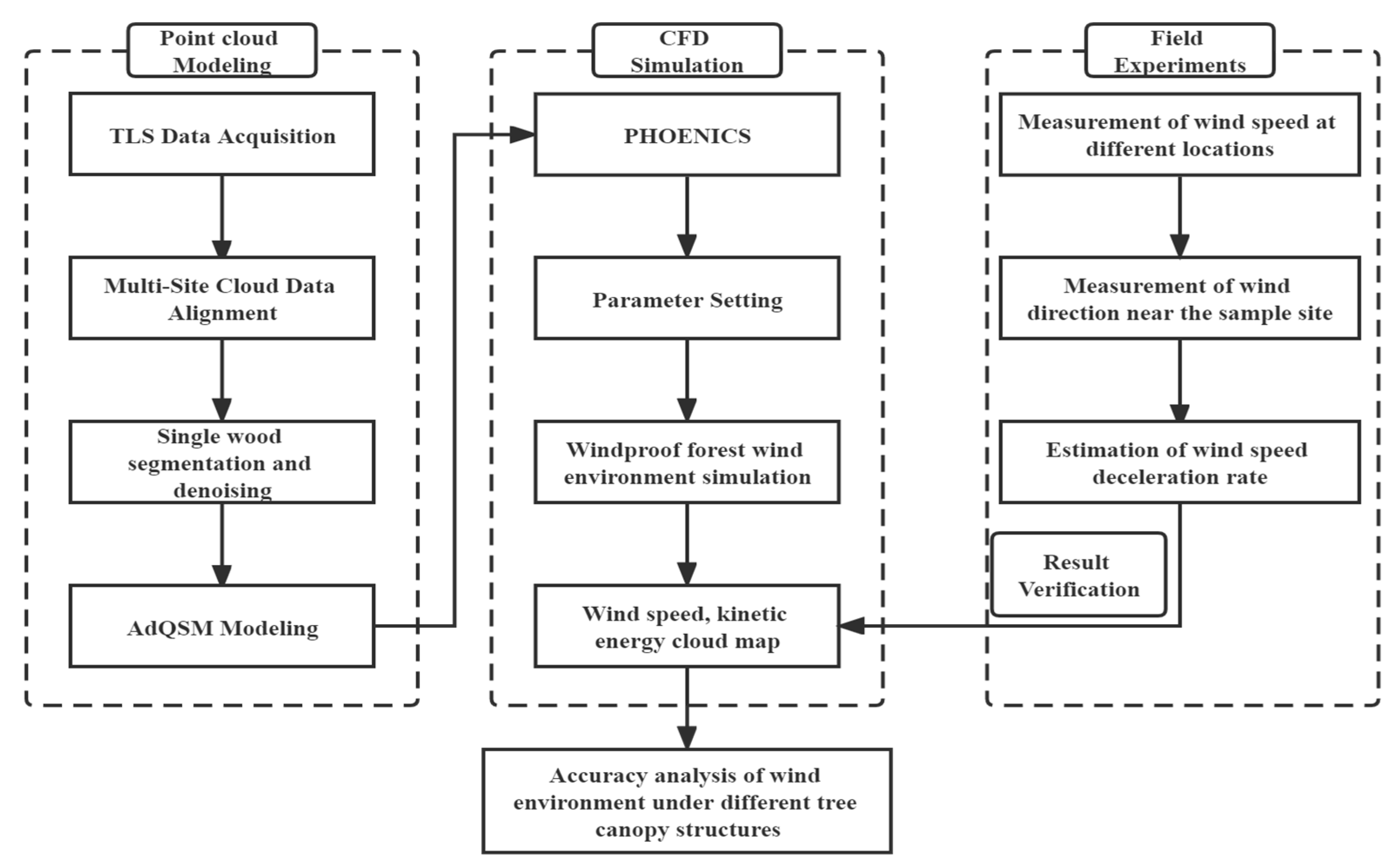

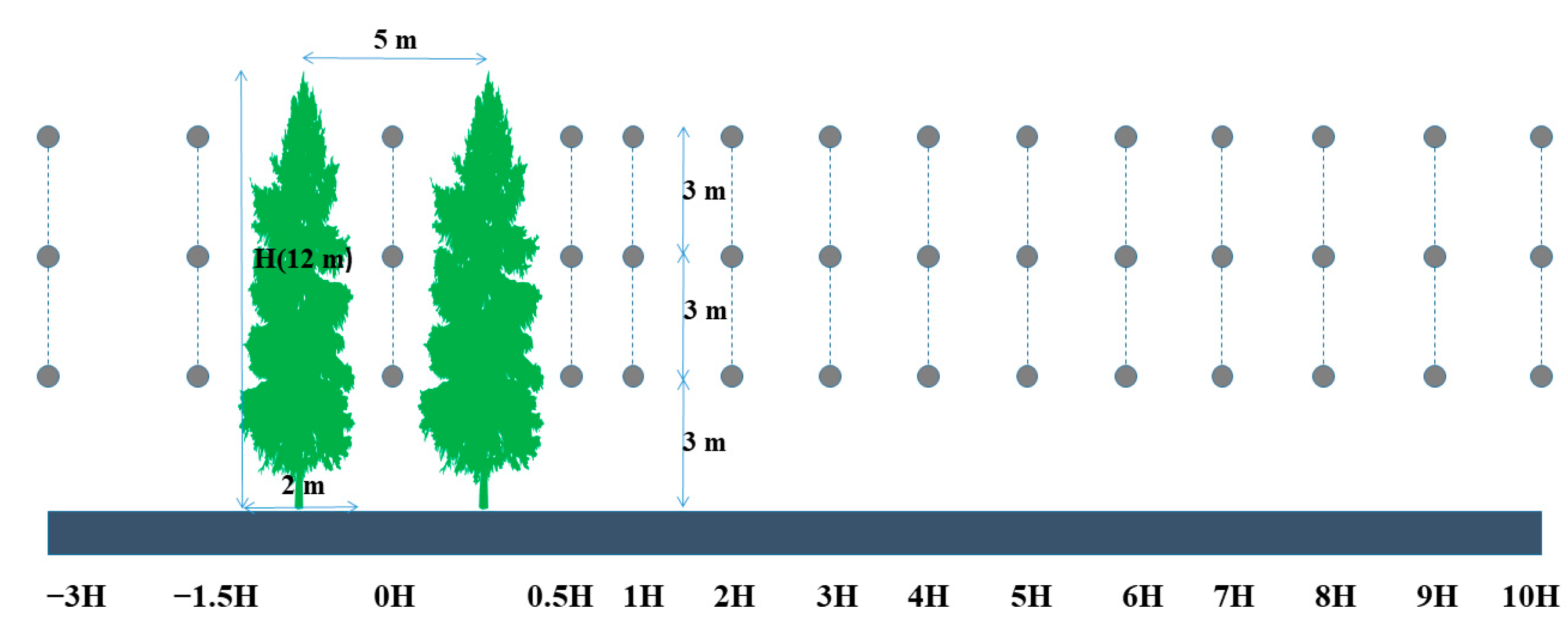
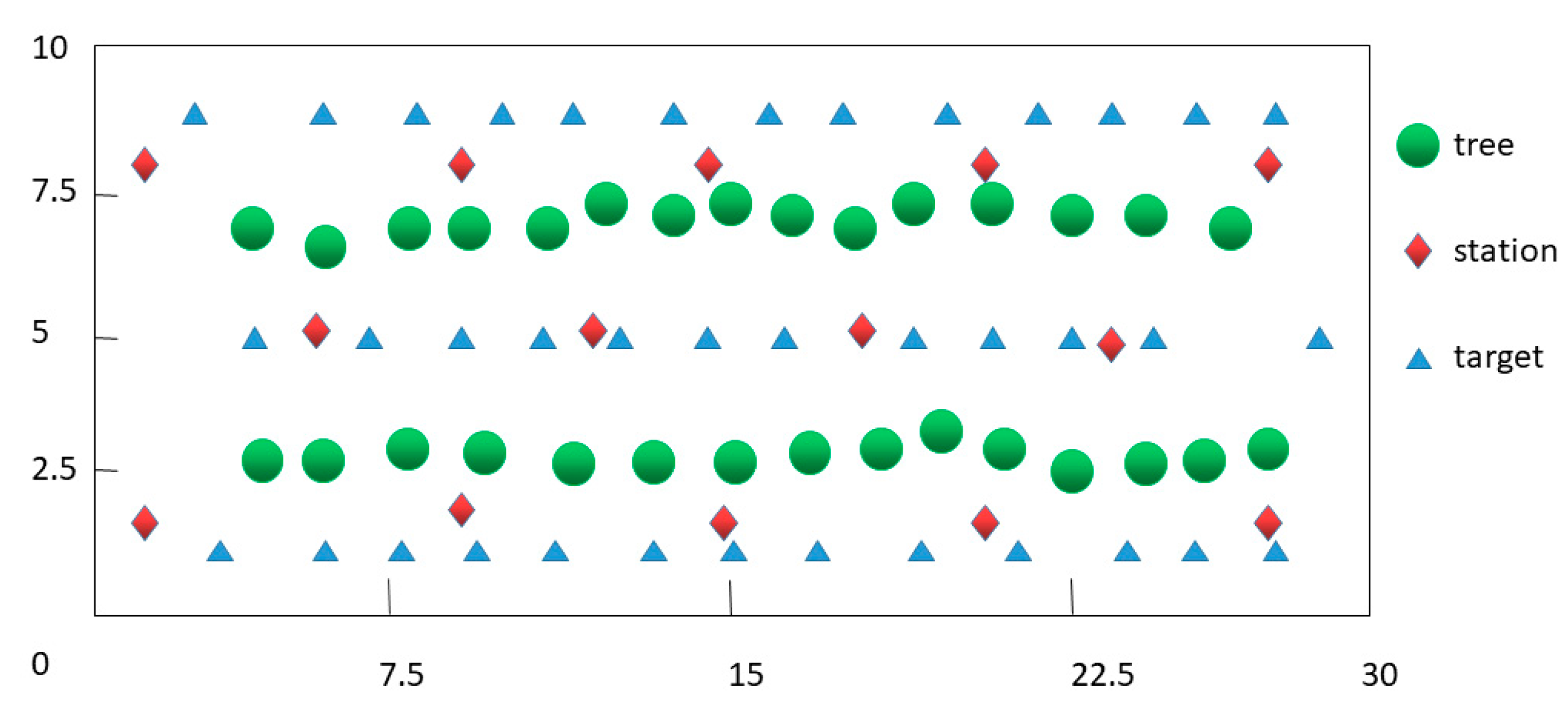
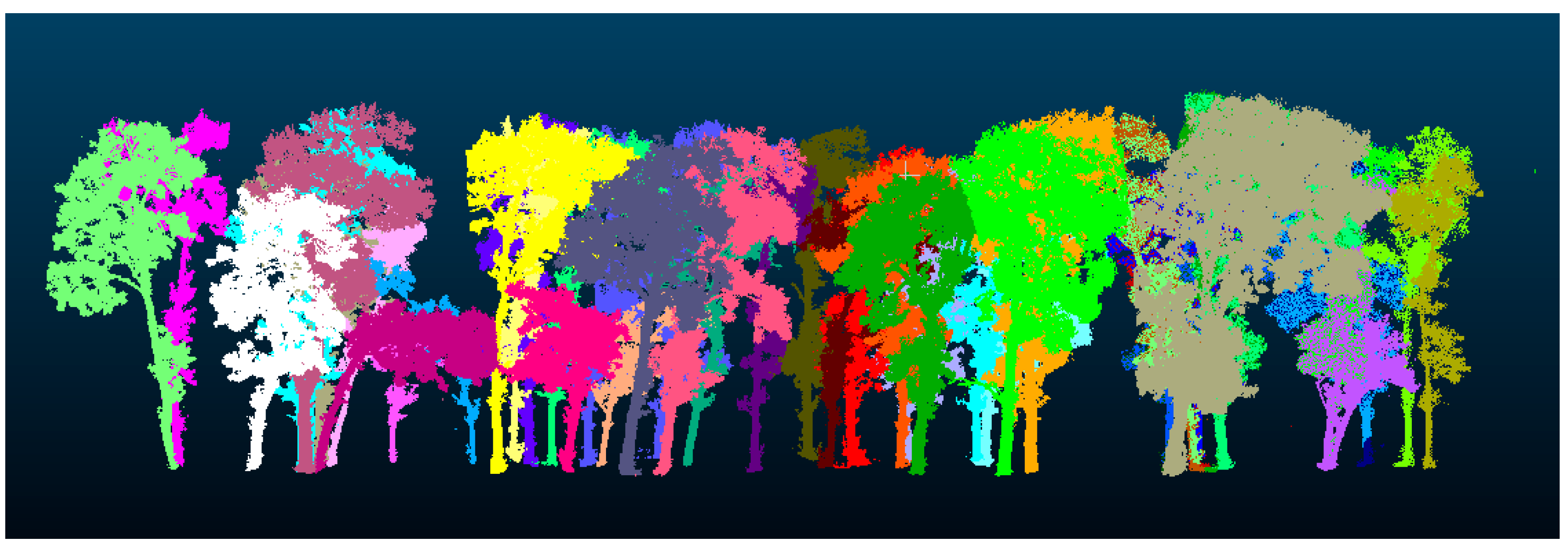


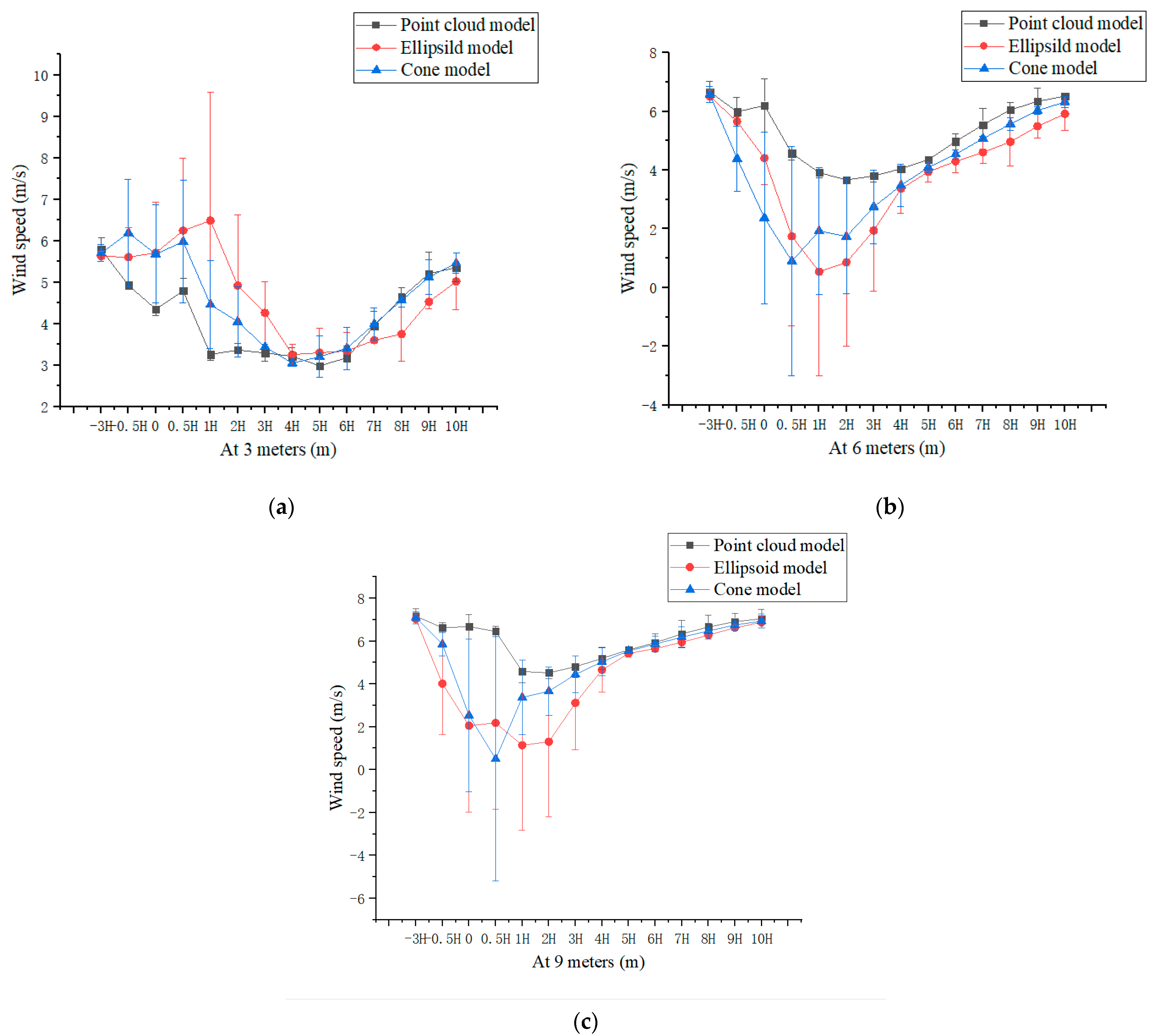
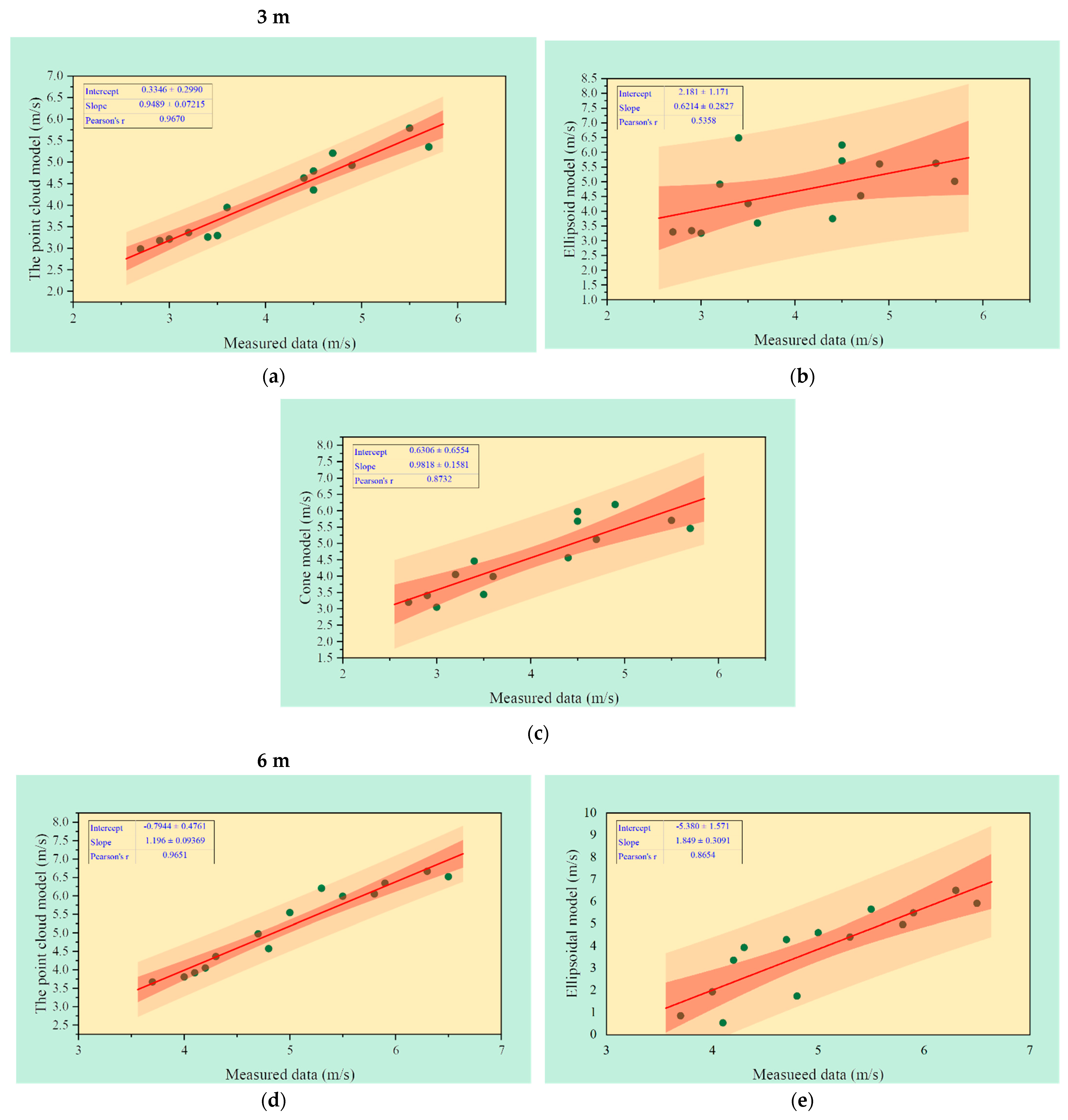
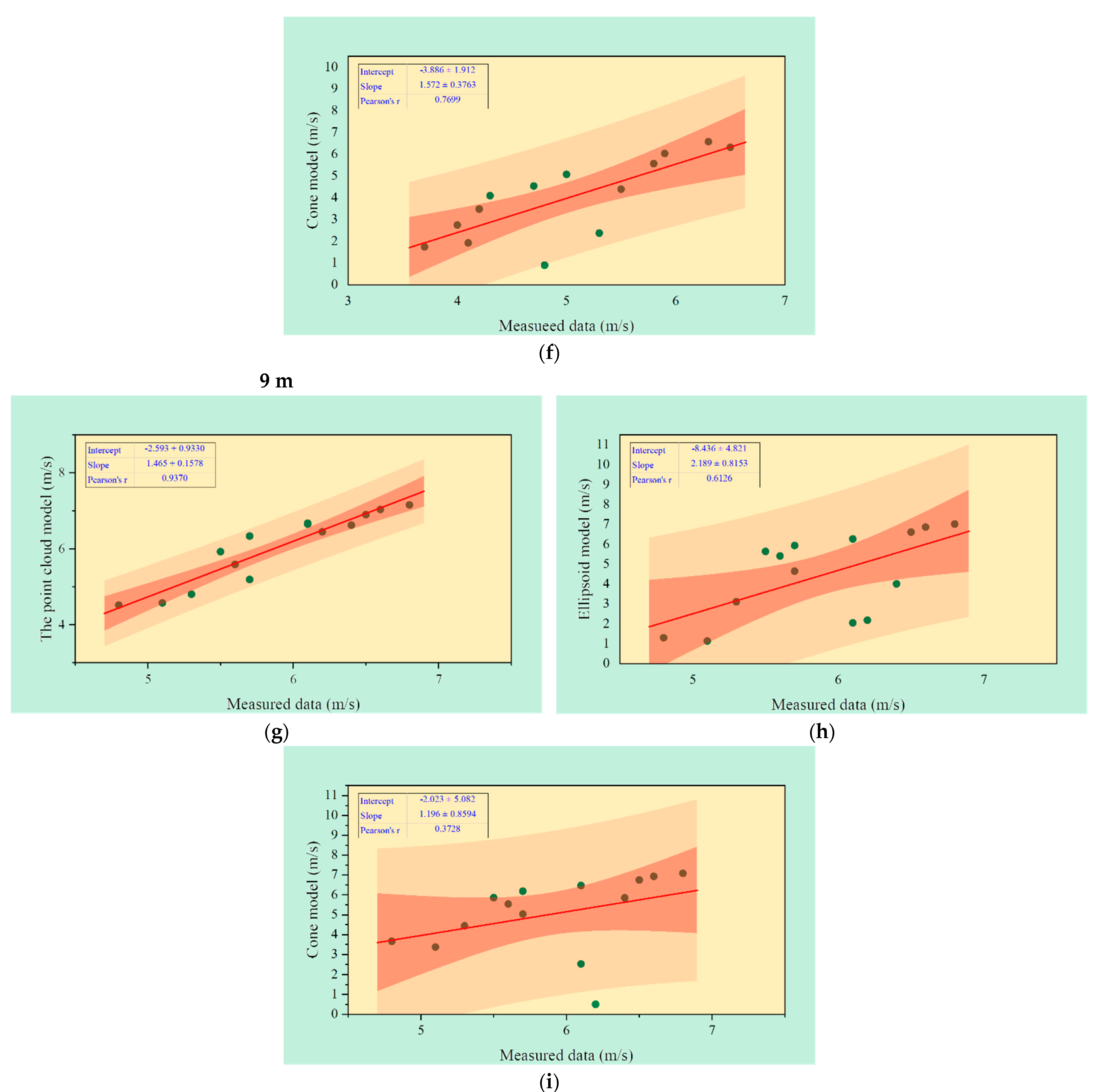
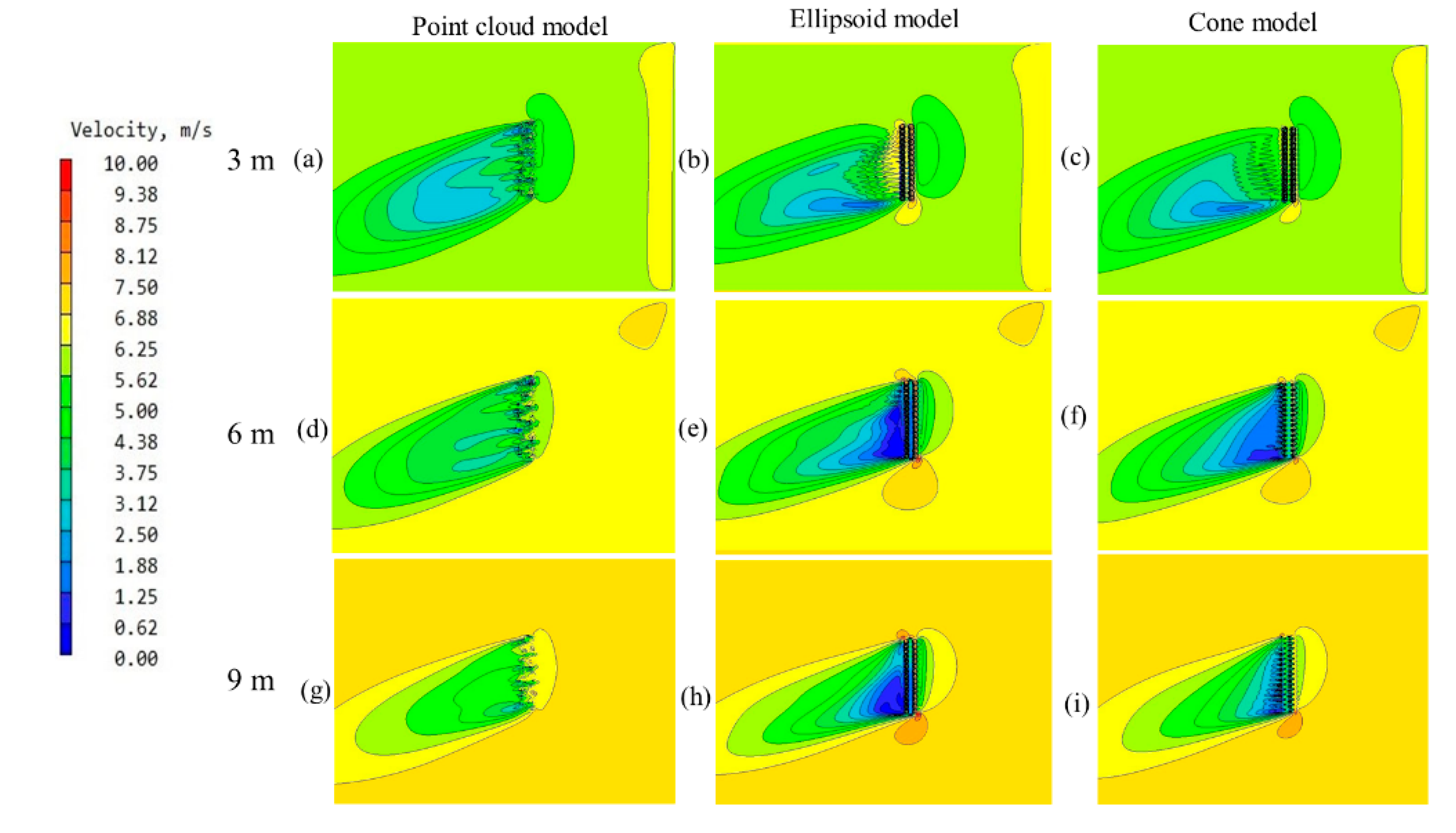
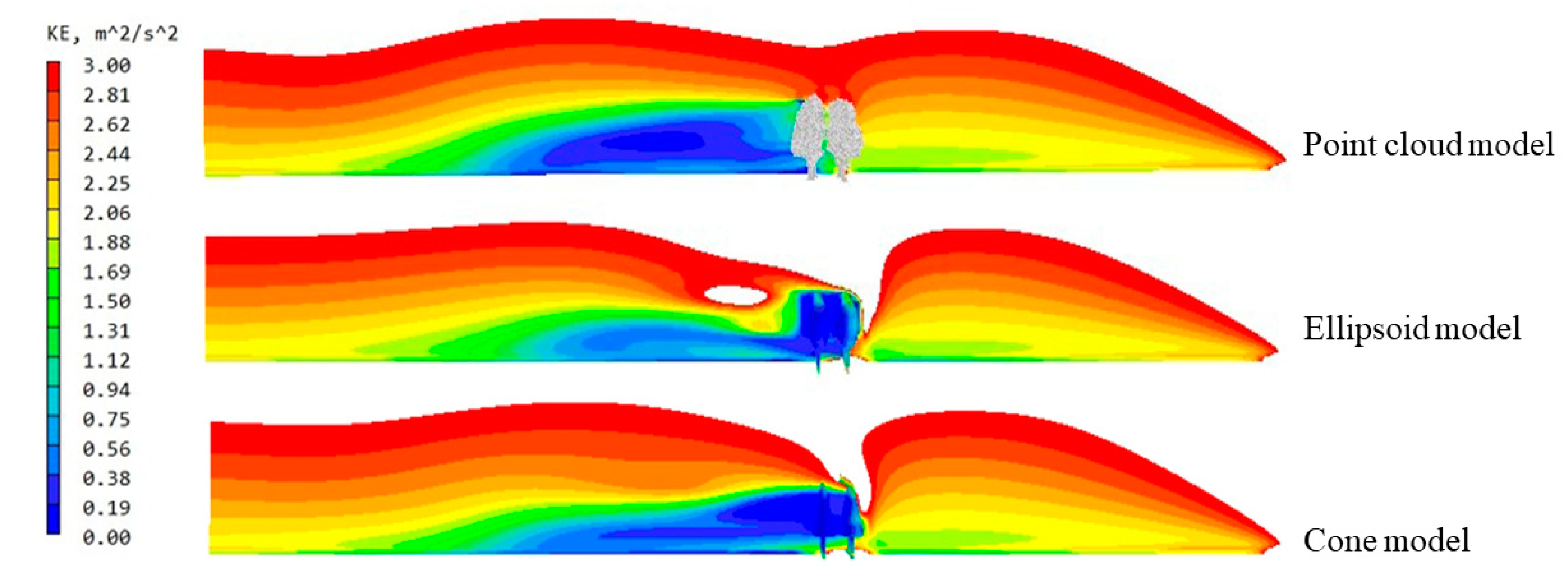

| Stem Density | Tree Height (Min~Max/Mean)/m | Sample Plot Size /(m × m) | Diameter (Min~Max/Mean)/cm |
|---|---|---|---|
| 472 | 5.7~14.3/12.1 | 30 × 10 | 18.7~55.2/32.95 |
| Variable | Sensor Type | Manufacturer | Accuracy | Resolution Ratio | Measurement Range |
|---|---|---|---|---|---|
| Wind speed | YGC-FS | YIGU Brand | ±(0.3 + 0.03 V)/s | 0.1 m/s | 0–45 m/s |
| Wind direction | YGC-FX | YIGU Brand | 0–360° | 1° | 0–360° |
| Performance Index | FARO Focus 3D X330 |
|---|---|
| Max. range/m | 330 |
| Scanning speed/(points/s) | 976,000 |
| Range error/mm | 2 |
| Visible range/(°) | 300° (V) × 360° (H) |
| Scanning resolution/(°) | 0.009° (V) × 0.009° (H) |
| Laser wavelength/nm | 1550 |
| Model Type | Location | Absolute Error (m/s) | Relative Error (%) | Root Mean Square Error (m/s) | ||||||
|---|---|---|---|---|---|---|---|---|---|---|
| 3 m | 6 m | 9 m | 3 m | 6 m | 9 m | 3 m | 6 m | 9 m | ||
| Point cloud model | −3 H | 0.292 | 0.369 | 0.359 | 5.3 | 5.9 | 5.3 | 0.272 | 0.377 | 0.437 |
| −0.5 H | 0.028 | 0.491 | 0.224 | 0.6 | 8.9 | 3.5 | ||||
| 0 H | 0.147 | 0.906 | 0.575 | 3.3 | 17.1 | 9.4 | ||||
| 0.5 H | 0.293 | 0.225 | 0.249 | 6.5 | 4.7 | 4.0 | ||||
| 1 H | 0.141 | 0.181 | 0.525 | 4.1 | 4.4 | 10.3 | ||||
| 2 H | 0.163 | 0.029 | 0.284 | 5.1 | 0.8 | 5.9 | ||||
| 3 H | 0.206 | 0.195 | 0.495 | 5.9 | 4.9 | 9.3 | ||||
| 4 H | 0.212 | 0.150 | 0.507 | 7.1 | 3.6 | 8.9 | ||||
| 5 H | 0.284 | 0.061 | 0.011 | 10.5 | 1.4 | 0.2 | ||||
| 6 H | 0.276 | 0.277 | 0.426 | 9.5 | 5.9 | 7.7 | ||||
| 7 H | 0.347 | 0.548 | 0.637 | 9.6 | 11 | 11.2 | ||||
| 8 H | 0.231 | 0.254 | 0.553 | 5.3 | 4.4 | 9.1 | ||||
| Ellipsoid model | −3 H | 0.128 | 0.214 | 0.227 | 2.3 | 3.4 | 3.3 | 1.184 | 1.635 | 2.272 |
| −0.5 H | 0.705 | 0.160 | 2.385 | 14.4 | 2.9 | 37.3 | ||||
| 0 H | 1.212 | 0.890 | 4.047 | 26.9 | 16.8 | 66.3 | ||||
| 0.5 H | 1.747 | 3.050 | 4.017 | 38.8 | 63.5 | 64.8 | ||||
| 1 H | 3.088 | 3.558 | 3.961 | 90.8 | 86.8 | 77.7 | ||||
| 2 H | 1.718 | 2.839 | 3.495 | 53.7 | 76.7 | 72.8 | ||||
| 3 H | 0.761 | 2.056 | 2.186 | 21.7 | 51.4 | 41.2 | ||||
| 4 H | 0.255 | 0.831 | 1.045 | 8.5 | 19.8 | 18.3 | ||||
| 5 H | 0.600 | 0.355 | 0.178 | 22.2 | 8.3 | 3.2 | ||||
| 6 H | 0.442 | 0.399 | 0.149 | 15.2 | 8.5 | 2.7 | ||||
| 7 H | 0.002 | 0.391 | 0.245 | 0.1 | 7.8 | 4.3 | ||||
| 8 H | 0.652 | 0.831 | 0.177 | 14.8 | 14.3 | 2.9 | ||||
| Cone model | −3 H | 0.205 | 0.281 | 0.286 | 3.7 | 4.5 | 4.2 | 0.759 | 1.600 | 1.921 |
| −0.5 H | 1.292 | 1.105 | 0.548 | 26.4 | 20.1 | 8.6 | ||||
| 0 H | 1.181 | 2.923 | 3.565 | 26.2 | 55.2 | 58.4 | ||||
| 0.5 H | 1.478 | 3.897 | 5.697 | 28.2 | 81.2 | 91.9 | ||||
| 1 H | 1.060 | 2.172 | 1.726 | 31.2 | 53.0 | 33.8 | ||||
| 2 H | 0.849 | 1.957 | 1.139 | 26.5 | 52.9 | 23.7 | ||||
| 3 H | 0.062 | 1.250 | 0.859 | 1.8 | 31.3 | 16.2 | ||||
| 4 H | 0.049 | 0.717 | 0.665 | 1.6 | 17.1 | 11.7 | ||||
| 5 H | 0.500 | 0.200 | 0.060 | 18.5 | 4.7 | 1.1 | ||||
| 6 H | 0.509 | 0.157 | 0.360 | 17.6 | 3.3 | 6.5 | ||||
| 7 H | 0.390 | 0.080 | 0.484 | 10.8 | 1.6 | 8.5 | ||||
| 8 H | 0.165 | 0.229 | 0.370 | 3.8 | 3.9 | 6.1 | ||||
| Serial No. | Diameter (cm) | Tree Height (m) | Average Crown Width (m) | |||||||||
|---|---|---|---|---|---|---|---|---|---|---|---|---|
| Measured | Point Cloud Modeling | Absolute Error (cm) | Relative Error (%) | Measured | Point Cloud Modeling | Absolute Error (cm) | Relative Error (%) | Measured | Point Cloud Modeling | Absolute Error (cm) | Relative Error (%) | |
| 1 | 43.452 | 43.890 | 0.428 | 0.98 | 12.754 | 12.879 | 0.125 | 0.98 | 2.04 | 2.236 | 0.196 | 9.60 |
| 2 | 40.198 | 40.307 | 0.109 | 0.27 | 9.983 | 9.998 | 0.015 | 0.15 | 3.42 | 3.117 | 0.303 | 8.86 |
| 3 | 46.874 | 47.024 | 0.150 | 0.32 | 13.936 | 13.661 | 0.275 | 2.00 | 3.35 | 3.628 | 0.278 | 8.30 |
| 4 | 44.513 | 44.405 | 0.108 | 0.24 | 8.573 | 8.582 | 0.009 | 0.10 | 4.26 | 3.903 | 0.357 | 8.38 |
| 5 | 31.637 | 31.422 | 0.215 | 0.68 | 13.544 | 13..571 | 0.027 | 0.20 | 3.03 | 2.848 | 0.182 | 6.00 |
Publisher’s Note: MDPI stays neutral with regard to jurisdictional claims in published maps and institutional affiliations. |
© 2022 by the authors. Licensee MDPI, Basel, Switzerland. This article is an open access article distributed under the terms and conditions of the Creative Commons Attribution (CC BY) license (https://creativecommons.org/licenses/by/4.0/).
Share and Cite
An, L.; Wang, J.; Xiong, N.; Wang, Y.; You, J.; Li, H. Assessment of Permeability Windbreak Forests with Different Porosities Based on Laser Scanning and Computational Fluid Dynamics. Remote Sens. 2022, 14, 3331. https://doi.org/10.3390/rs14143331
An L, Wang J, Xiong N, Wang Y, You J, Li H. Assessment of Permeability Windbreak Forests with Different Porosities Based on Laser Scanning and Computational Fluid Dynamics. Remote Sensing. 2022; 14(14):3331. https://doi.org/10.3390/rs14143331
Chicago/Turabian StyleAn, Likun, Jia Wang, Nina Xiong, Yutang Wang, Jiashuo You, and Hao Li. 2022. "Assessment of Permeability Windbreak Forests with Different Porosities Based on Laser Scanning and Computational Fluid Dynamics" Remote Sensing 14, no. 14: 3331. https://doi.org/10.3390/rs14143331
APA StyleAn, L., Wang, J., Xiong, N., Wang, Y., You, J., & Li, H. (2022). Assessment of Permeability Windbreak Forests with Different Porosities Based on Laser Scanning and Computational Fluid Dynamics. Remote Sensing, 14(14), 3331. https://doi.org/10.3390/rs14143331






